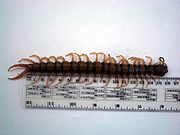
Ethmostigmus rubripes
Encyclopedia
Ethmostigmus rubripes, the giant centipede, is the largest Australasian and Asian centipede
. Head and body length 7.5 to over 16 cm (6¼ inches). The body is long and flattened. Coloration is dark or greenish-brown to orange or orange-yellow with black bands, with yellow legs and antennae; southern specimens tend to have blue or dark antennae. Ethmostigmus rubripes also have various subspecies which may explain the many colour forms of this species.
and a nocturnal predator. It is common throughout Australia
, the Solomon Islands
, New Guinea
, Indonesia
, Southeast Asia
and China
.
The giant centipede has modified claws called forcipules which curve around its head and can deliver venom
into its prey. The venom is toxic to both mammal
s and insect
s, but does not appear to be strong enough to kill large animals quickly. It can cause severe pain in humans which can last for several days but which can be relieved somewhat by the application of icepacks. Some people report "intense pain", while others claim it is no worse than a wasp sting. There has been at least one reported death from the related centipede species Scolopendra subspinipes
in which a young girl was bitten and died.

Centipede
Centipedes are arthropods belonging to the class Chilopoda of the subphylum Myriapoda. They are elongated metameric animals with one pair of legs per body segment. Despite the name, centipedes can have a varying number of legs from under 20 to over 300. Centipedes have an odd number of pairs of...
. Head and body length 7.5 to over 16 cm (6¼ inches). The body is long and flattened. Coloration is dark or greenish-brown to orange or orange-yellow with black bands, with yellow legs and antennae; southern specimens tend to have blue or dark antennae. Ethmostigmus rubripes also have various subspecies which may explain the many colour forms of this species.
Habitat and range
It is found in both dry and moist habitats, usually in sheltered places such as under logs, leaf litter and bark, and under rocks. It is solitary, terrestrialTerrestrial animal
Terrestrial animals are animals that live predominantly or entirely on land , as compared with aquatic animals, which live predominantly or entirely in the water , or amphibians, which rely on a combination of aquatic and terrestrial habitats...
and a nocturnal predator. It is common throughout Australia
Australia
Australia , officially the Commonwealth of Australia, is a country in the Southern Hemisphere comprising the mainland of the Australian continent, the island of Tasmania, and numerous smaller islands in the Indian and Pacific Oceans. It is the world's sixth-largest country by total area...
, the Solomon Islands
Solomon Islands
Solomon Islands is a sovereign state in Oceania, east of Papua New Guinea, consisting of nearly one thousand islands. It covers a land mass of . The capital, Honiara, is located on the island of Guadalcanal...
, New Guinea
New Guinea
New Guinea is the world's second largest island, after Greenland, covering a land area of 786,000 km2. Located in the southwest Pacific Ocean, it lies geographically to the east of the Malay Archipelago, with which it is sometimes included as part of a greater Indo-Australian Archipelago...
, Indonesia
Indonesia
Indonesia , officially the Republic of Indonesia , is a country in Southeast Asia and Oceania. Indonesia is an archipelago comprising approximately 13,000 islands. It has 33 provinces with over 238 million people, and is the world's fourth most populous country. Indonesia is a republic, with an...
, Southeast Asia
Southeast Asia
Southeast Asia, South-East Asia, South East Asia or Southeastern Asia is a subregion of Asia, consisting of the countries that are geographically south of China, east of India, west of New Guinea and north of Australia. The region lies on the intersection of geological plates, with heavy seismic...
and China
China
Chinese civilization may refer to:* China for more general discussion of the country.* Chinese culture* Greater China, the transnational community of ethnic Chinese.* History of China* Sinosphere, the area historically affected by Chinese culture...
.
The giant centipede has modified claws called forcipules which curve around its head and can deliver venom
Venom
Venom is the general term referring to any variety of toxins used by certain types of animals that inject it into their victims by the means of a bite or a sting...
into its prey. The venom is toxic to both mammal
Mammal
Mammals are members of a class of air-breathing vertebrate animals characterised by the possession of endothermy, hair, three middle ear bones, and mammary glands functional in mothers with young...
s and insect
Insect
Insects are a class of living creatures within the arthropods that have a chitinous exoskeleton, a three-part body , three pairs of jointed legs, compound eyes, and two antennae...
s, but does not appear to be strong enough to kill large animals quickly. It can cause severe pain in humans which can last for several days but which can be relieved somewhat by the application of icepacks. Some people report "intense pain", while others claim it is no worse than a wasp sting. There has been at least one reported death from the related centipede species Scolopendra subspinipes
Scolopendra subspinipes
Scolopendra subspinipes is a species of centipede occasionally reaching 19 cm in length. This is large for a centipede, but there are several larger species. It is found throughout tropical and subtropical regions of the world, and is one of only three species of centipedes in Hawaii. It is...
in which a young girl was bitten and died.


